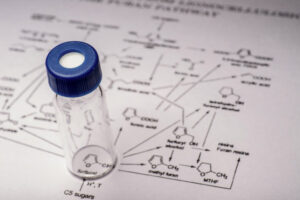Mass spectrometry is a powerful qualitative and quantitative analytical detection technique that is used to identify and quantify an analyte in a sample by making use of its specific mass-to-charge ratio. When coupled with liquid- or gas chromatography, mass spectrometers allow for the expansion of analytical capabilities to countless applications.

Liquid- vs Gas Chromatography:
Chromatography describes the process of separating and identifying analytes/compounds within a complex mixture. Although there are several different chromatography methods to choose from, liquid- and gas chromatography are two of the most often used methods.
Liquid chromatography (LC) is used to separate compounds in solution (liquid) based on their interaction with the mobile- (liquid) and stationary (solid) phases. This interaction may be dependent on differences in polarity, size and even stoichiometry of different analytes. Individual components in a complex mixture are therefore resolved from each other based on their specific interaction with the stationary phase. The resolved analytes can subsequently be detected and quantified using a mass spectrometer (MS).
On the other hand, Gas chromatography (GC) separates the components in a mixture based on their physical characteristics which include boiling point, molecular weight, size and shape. A sample can therefore be separated into its constituents based on the length and temperature of the column, and the flow rate of the carrier gas. A sample for gas chromatography must therefore be volatile and temperature stable, meaning it must be able to enter the gas phase while not degrading prior to detection. A sample is diluted and vaporized in a high-temperature environment inside the injection port of the chromatograph. The analytes enter the MS for analyses as they elute from the column.
The food industry carries the essential responsibility to deliver food products that are highly nutritious, safe and of high quality. Analytical techniques to evaluate food samples for a wide range of parameters, ranging from assessing food authenticity, flavour profiling and the identification and quantification of compounds are essential. So how do you know whether your sample should be analysed with liquid- or rather with gas chromatography? Well depending on the sample, some analytes are not as soluble, making them more difficult to analyse by LC. Other analytes may be sensitive to high temperatures, which makes them better-suited for analyses with LC than with GC. LC can be used to analyse compounds which can be either volatile or non-volatile. Examples of such substances include carbohydrates, amino acids, pesticides, etc. However, with GC a sample mixture has to be volatile, meaning this technique is typically used for the separation of volatile samples and other unknown organic compounds. Some analytes can be analysed with both LC and GC, but the limit of detection may vary between the two techniques depending on the analyte structure, its ability to ionise, etc.
So what is the significance of all this? Liquid- and Gas chromatography, coupled with mass spectrometry is applicable across diverse fields, including the food industry, clinical research, pharma/biopharma, proteomics, metabolomics and even forensic toxicology. Some specific applications for MS include drug testing and discovery, pesticide residue analysis, food contamination detection, protein identification and isotope ratio determination, to name a few! Therefore, being able to identify and quantify even the tiniest analytes in complex mixtures with incredible precision makes MS an indispensable tool in research, diagnostics, and beyond!